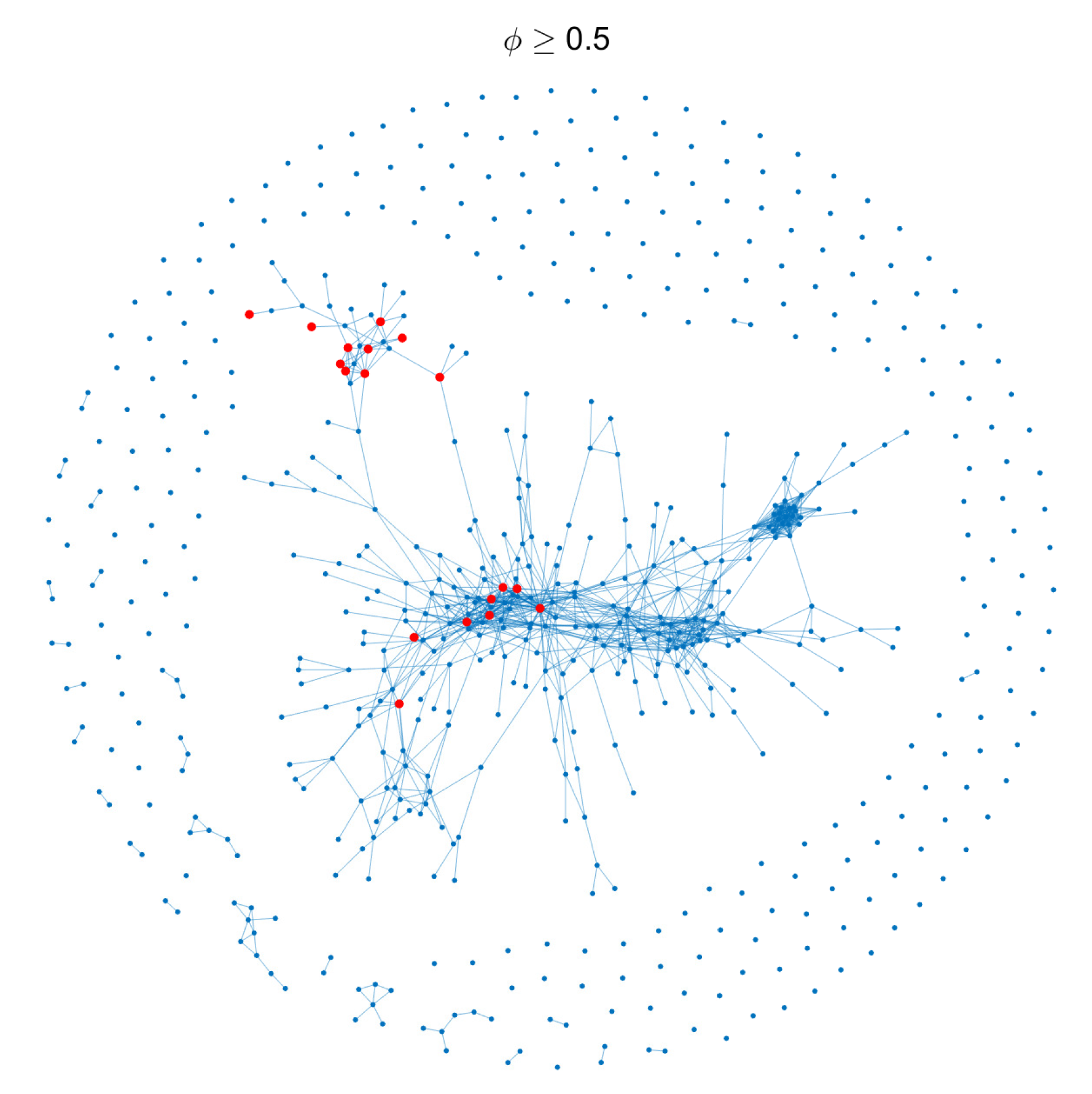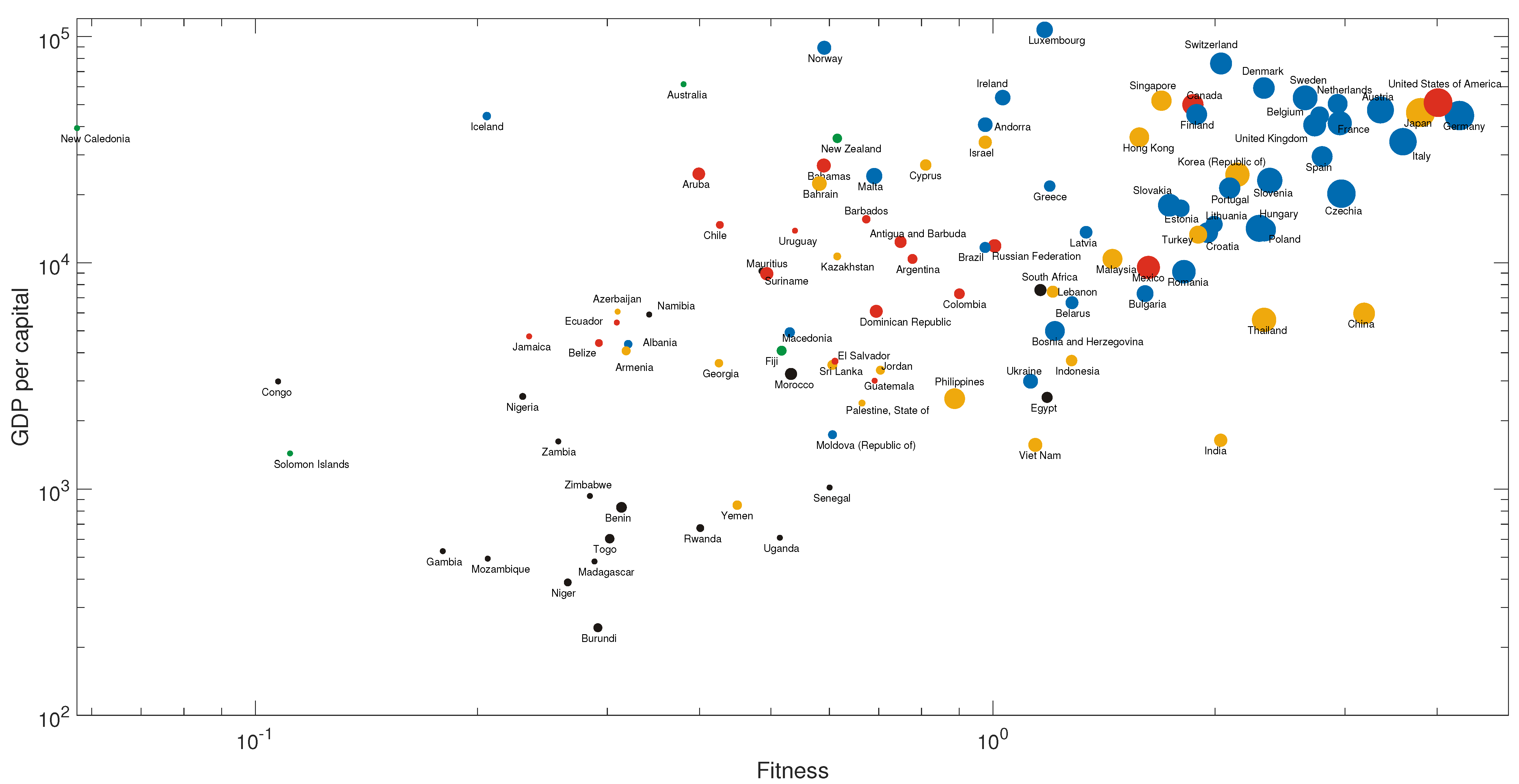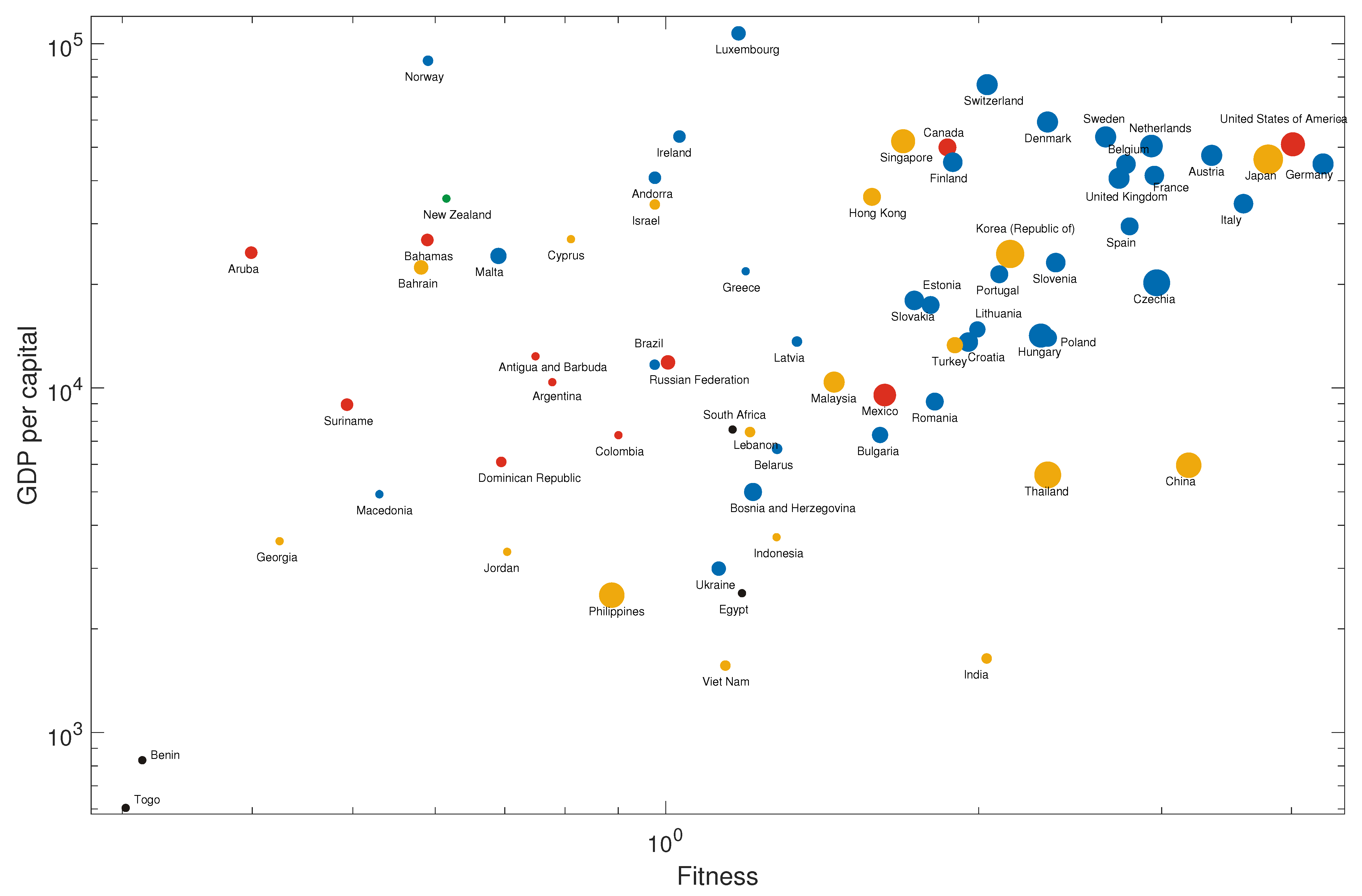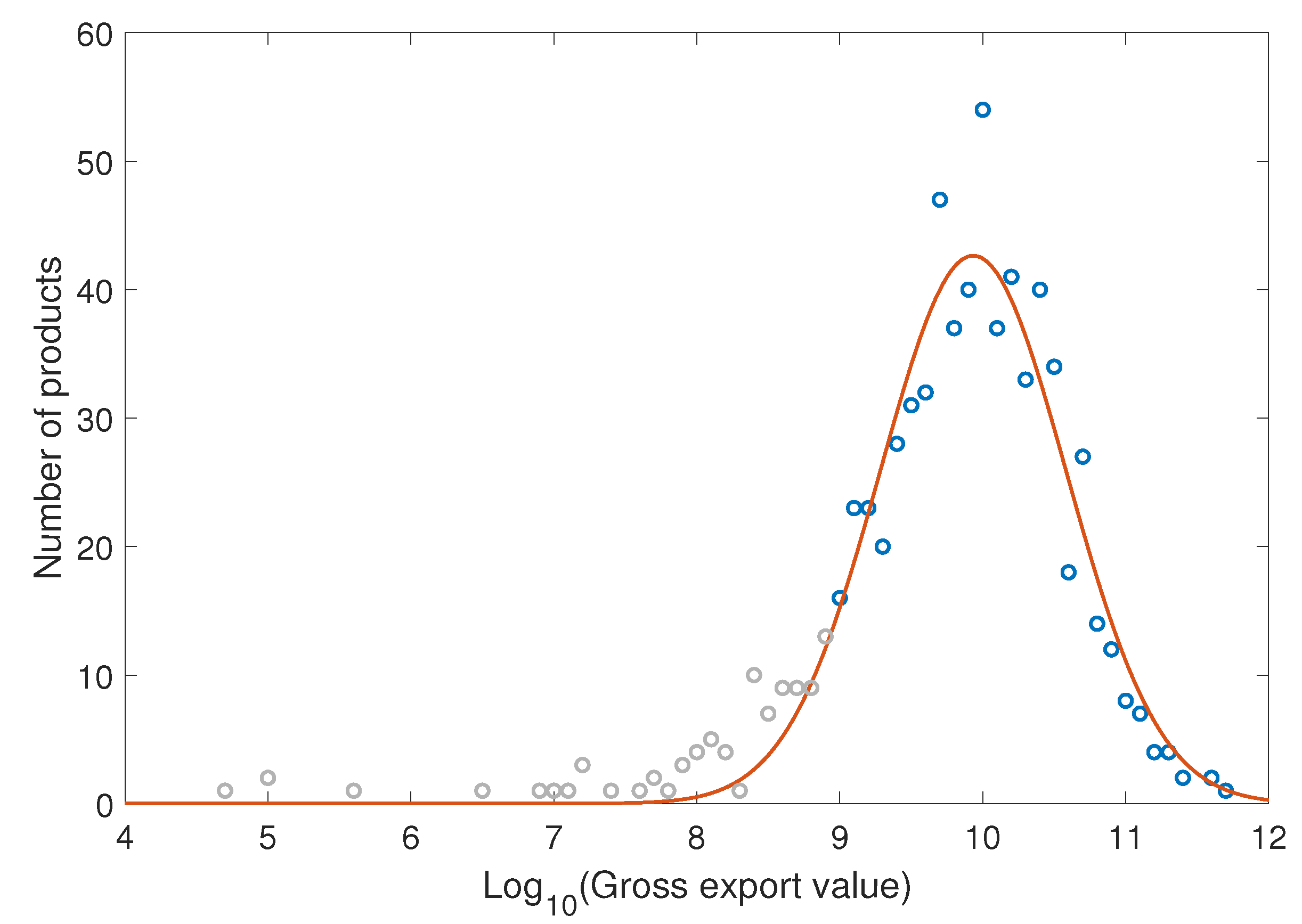Industry Upgrading: Recommendations of New Products Based on World Trade Network
Abstract
1. Introduction
2. Results
2.1. Prediction Ability of Proximity
2.2. Recommending New Products to Countries
3. Discussion
4. Materials and Methods
4.1. Data Description
4.2. Revealed Comparative Advantage
4.3. Proximity
4.4. Fitness–Complexity Algorithm
Author Contributions
Funding
Acknowledgments
Conflicts of Interest
Appendix A. “Core Products” and Their Neighbors
References
- Ren, Z.M.; Zeng, A.; Zhang, Y.C. Structure-oriented prediction in complex networks. Phys. Rep. 2018, 750, 1–51. [Google Scholar] [CrossRef]
- Hausmann, R.; Hwang, J.; Rodrik, D. What you export matters. J. Econ. Growth 2007, 12, 1–25. [Google Scholar] [CrossRef]
- Hidalgo, C.A.; Hausmann, R. The building blocks of economic complexity. Proc. Natl. Acad. Sci. USA 2009, 106, 10570–10575. [Google Scholar] [CrossRef] [PubMed]
- Tacchella, A.; Cristelli, M.; Caldarelli, G.; Gabrielli, A.; Pietronero, L. A new metrics for countries’ fitness and products’ complexity. Sci. Rep. 2012, 2, 723. [Google Scholar] [CrossRef] [PubMed]
- Cristelli, M.; Gabrielli, A.; Tacchella, A.; Caldarelli, G.; Pietronero, L. Measuring the intangibles: A metrics for the economic complexity of countries and products. PLoS ONE 2013, 8, e70726. [Google Scholar] [CrossRef] [PubMed]
- Tacchella, A.; Cristelli, M.; Caldarelli, G.; Gabrielli, A.; Pietronero, L. Economic complexity: Conceptual grounding of a new metrics for global competitiveness. J. Econ. Dyn. Control 2013, 37, 1683–1691. [Google Scholar] [CrossRef]
- Pugliese, E.; Zaccaria, A.; Pietronero, L. On the convergence of the Fitness-Complexity Algorithm. Eur. Phys. J. Spec. Top. 2016, 225, 1893–1911. [Google Scholar] [CrossRef]
- Wu, R.J.; Shi, G.Y.; Zhang, Y.C.; Mariani, M.S. The mathematics of non-linear metrics for nested networks. Phys. A Stat. Mech. Its Appl. 2016, 460, 254–269. [Google Scholar] [CrossRef]
- Cristelli, M.; Tacchella, A.; Pietronero, L. The heterogeneous dynamics of economic complexity. PLoS ONE 2015, 10, e0117174. [Google Scholar] [CrossRef] [PubMed]
- Zaccaria, A.; Cristelli, M.; Kupers, R.; Tacchella, A.; Pietronero, L. A case study for a new metrics for economic complexity: The Netherlands. J. Econ. Interact. Coord. 2016, 11, 151–169. [Google Scholar] [CrossRef]
- Gao, J.; Zhou, T. Quantifying China’s regional economic complexity. Phys. A Stat. Mech. Appl. 2018, 492, 1591–1603. [Google Scholar] [CrossRef]
- Hidalgo, C.A.; Klinger, B.; Barabási, A.L.; Hausmann, R. The product space conditions the development of nations. Science 2007, 317, 482–487. [Google Scholar] [CrossRef] [PubMed]
- Alshamsi, A.; Pinheiro, F.L.; Hidalgo, C.A. Optimal diversification strategies in the networks of related products and of related research areas. Nat. Commun. 2018, 9, 1328. [Google Scholar] [CrossRef] [PubMed]
- Vidmer, A.; Zeng, A.; Medo, M.; Zhang, Y.C. Prediction in complex systems: The case of the international trade network. Phys. A Stat. Mech. Appl. 2015, 436, 188–199. [Google Scholar] [CrossRef]
- International Trade Statistics Database, Comtrade, UN. Available online: https://comtrade.un.org (accessed on 4 January 2019).
- National Accounts Main Aggregates Database, United Nations Statistics Division, UN. Available online: https://unstats.un.org/unsd/snaama/dnllist.asp (accessed on 4 January 2019).
- Balassa, B. Trade liberalisation and “revealed” comparative advantage 1. Manch. Sch. 1965, 33, 99–123. [Google Scholar] [CrossRef]






| Existing Industries | Predicted Industries |
|---|---|
| Recommendation list for Burundi: | |
| Parts of Metalworking Machine Tools | Pulley System Parts |
| Video and Sound Recorders | Miscellaneous Office Equipment |
| Video and Sound Recorders | Computer Peripherals |
| Parts of Metalworking Machine Tools | Automotive Electrical Equipment |
| Parts of Metalworking Machine Tools | Vehicles Parts and Accessories |
| Recommendation list for Togo: | |
| Miscellaneous Engines | Miscellaneous Heating and Cooling Equipment |
| Lifting and Loading Machinery | |
| Miscellaneous Engines | Pulley System Parts |
| Seamless Iron Tubes | Vehicles Parts and Accessories |
| Miscellaneous Engines | |
| Lifting and Loading Machinery | |
| Recommendation list for Philippines: | |
| Printing Machine Parts | Glycosides and Vaccines |
| Miscellaneous Centrifuge and Filtering Machinery | Motor Vehicles Piston Engines |
| Non-Electrical Counting Devices | |
| Control Instruments of Gas or Liquid | |
| Miscellaneous Centrifuge and Filtering Machinery | Piston Engine Parts |
| Control Instruments of Gas or Liquid | |
| Miscellaneous Metalworking Machinery | Machinery for Specialized Industries |
| Miscellaneous Engines | Pulley System Parts |
| Parts of Metalworking Machine Tools | |
| Miscellaneous Metalworking Machinery | |
| Miscellaneous Heating and Cooling Equipment | |
| Miscellaneous Centrifuge and Filtering Machinery | |
| Roller Bearings | |
| Computer Peripherals | CPUs |
| Vehicles Stereos | Color TVs |
| Computer Peripherals | Telecom Parts and Accessories |
| Vehicles Stereos | |
| Miscellaneous Power Machinery | |
| Printed Circuits | |
| Miscellaneous Electrical Machinery | |
| Computer Peripherals | Miscellaneous Electronic Circuit Parts |
| Computer Parts and Accessories | |
| Printed Circuits | |
| Diodes, Transistors and Photocells | |
| Electronic Microcircuits | |
| Optical Lenses | |
| Parts of Metalworking Machine Tools | Automotive Electrical Equipment |
| Circuit Breakers and Panels | |
| Non-Electrical Counting Devices | |
| Control Instruments of Gas or Liquid | |
| Miscellaneous Engines | Vehicles Parts and Accessories |
| Parts of Metalworking Machine Tools | |
| Miscellaneous Metalworking Machinery | |
| Circuit Breakers and Panels | |
© 2019 by the authors. Licensee MDPI, Basel, Switzerland. This article is an open access article distributed under the terms and conditions of the Creative Commons Attribution (CC BY) license (http://creativecommons.org/licenses/by/4.0/).
Share and Cite
Zhang, W.-Y.; Chen, B.-L.; Kong, Y.-X.; Shi, G.-Y.; Zhang, Y.-C. Industry Upgrading: Recommendations of New Products Based on World Trade Network. Entropy 2019, 21, 39. https://doi.org/10.3390/e21010039
Zhang W-Y, Chen B-L, Kong Y-X, Shi G-Y, Zhang Y-C. Industry Upgrading: Recommendations of New Products Based on World Trade Network. Entropy. 2019; 21(1):39. https://doi.org/10.3390/e21010039
Chicago/Turabian StyleZhang, Wen-Yao, Bo-Lun Chen, Yi-Xiu Kong, Gui-Yuan Shi, and Yi-Cheng Zhang. 2019. "Industry Upgrading: Recommendations of New Products Based on World Trade Network" Entropy 21, no. 1: 39. https://doi.org/10.3390/e21010039
APA StyleZhang, W.-Y., Chen, B.-L., Kong, Y.-X., Shi, G.-Y., & Zhang, Y.-C. (2019). Industry Upgrading: Recommendations of New Products Based on World Trade Network. Entropy, 21(1), 39. https://doi.org/10.3390/e21010039







